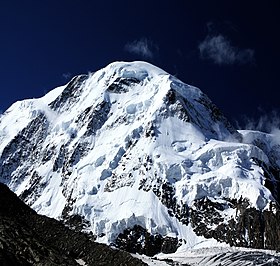Liskamm
| Lyskamm | |
|---|---|
| Liskamm | |

North-east side of Liskamm
|
|
| Highest point | |
| Elevation | 4,527 m (14,852 ft) |
| Prominence | 376 m ↓ Lisjoch |
| Isolation | 3 km (1.9 mi) → Zumsteinspitze |
| Parent peak | Monte Rosa |
| Coordinates | 45°55′21″N 7°50′08″E / 45.92250°N 7.83556°ECoordinates: 45°55′21″N 7°50′08″E / 45.92250°N 7.83556°E |
| Naming | |
| Translation | Lys Ridge |
| Geography | |
| Countries | Italy and Switzerland |
| Region/Canton | Aosta Valley and Valais |
| Parent range | Pennine Alps |
| Topo map | Swiss Federal Office of Topography swisstopo |
| Climbing | |
| First ascent | J. F. Hardy and party, 1861 |
| Easiest route | Basic glacier/snow climb/scrambling along exposed ridge |
Lyskamm (German: Liskamm, formerly Lyskamm, literally "comb of the Lys"), also known as Silberbast (literally "silver bast"), is a mountain (4,527 m (14,852 ft)) in the Pennine Alps lying on the border between Switzerland and Italy. It consists of a five-kilometre-long ridge with two distinct peaks. The mountain has gained a reputation for seriousness because of the many cornices lying on the ridge and the frequent avalanches, thus leading to its nickname the Menschenfresser ("people eater").
Because of its modest prominence (376 m), Liskamm is sometimes considered to be part of the extended Monte Rosa group (in fact the Dufourspitze is only 107 metres higher). But visually Liskamm is a huge massif, composed of two summits: the Eastern Liskamm and the lower Western Liskamm, separated by a 1 kilometre (0.62 mi) long ridge, both lying on the border between the Swiss canton of Valais (north) and the Italian region of the Aosta Valley (south).
The northern side of the mountain is an impressive 1,100 metres (3,600 ft) ice-covered wall, rising up from the Grenzgletscher. The gentler southern side rises only a few hundred metres above the glacier of the same name: Lysgletscher.
The eastern and higher of the two peaks is 4,527 m, and was first ascended in 1861 from the Lisjoch up the east ridge by a 14-man team (seven Englishmen, one Scotsman, and six Swiss guides) led by J. F. Hardy and including William Edward Hall. Others in the party included A. C. Ramsey, F. Sibson, T. Rennison, J. A. Hudson, C. H. Pilkington and R. M. Stephenson. The guides were Franz Josef Lochmatter (1825-1897) of St. Niklaus in the canton Valais, J.-P. Cachet, K. Kerr, S. Zumtaugwald, P. and J.-M. Perren.
...
Wikipedia

